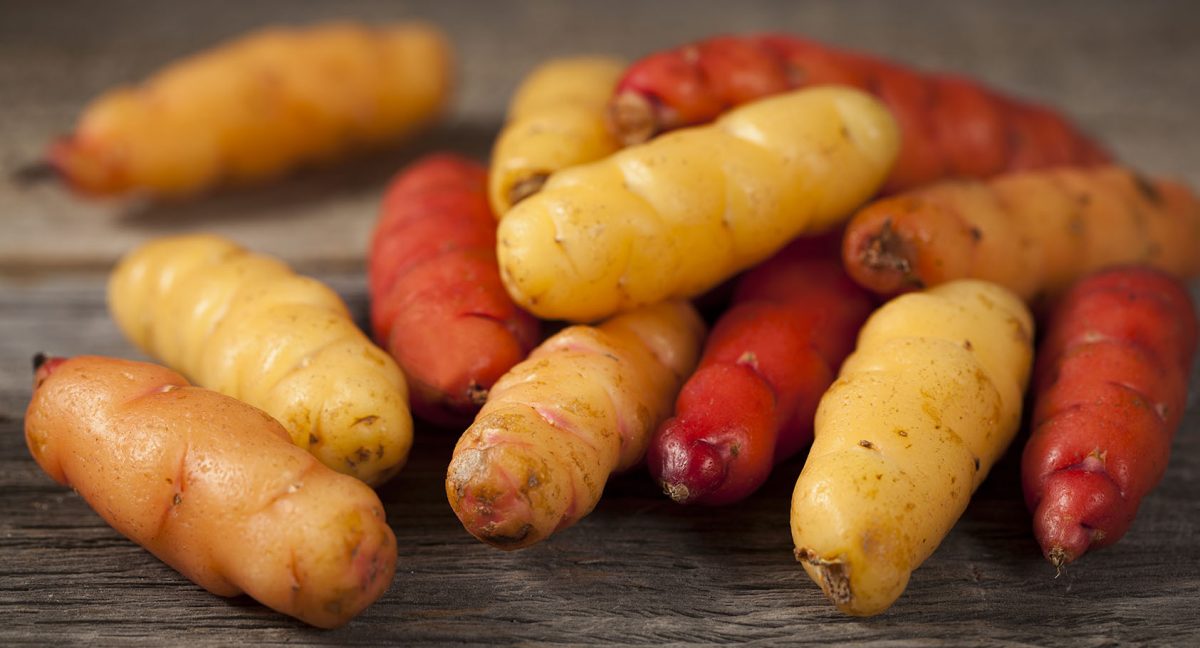Oca a lost crop of the Inca
What is Oca?
Oca belongs to the family of plants our native Irish wood sorrel belongs to, known in Irish Gaelic as Seamsóg no relation to our national plant the Shamrock which is Trifolium dubium. This plant cousin of our native sorrel comes from the mid level, wet, cool regions of the Andes Mountains which share a similar climate to the Irish climate. Our wood sorrel is botanically known as Oxalis acetosella whereas Oca is Oxalis tuberosa they are relatively closely related. But for the vagaries of history should have been introduced as one of the Andean crops brought to Ireland by the explorers, for various reasons this wonderful tuber got left behind. Oca is the second most important tuber crop of the Andean people only second to potato but historically was always planted in addition to potato and on higher poorer soils. This strategic use of Oca is an interesting lesson in food safety strategy developed over thousands of years. Another question for another day is if indeed it is a coincidence that our national plant the original Shamrock could possibly have been related to this plant but we leave this to the historians. Some scholars in the past have questioned the similarity of the name Shamrock to the gaelic name for wood sorrel, Seamsóg.
This reference from the International Potato Centre in Peru puts the importance of Oca succinctly. “Oca produces the second most widely cultivated tuber after potato. It is hardy and frost resistant, with long, cylindrical tubers from white to deep grayish purple. High in protein, with a good balance of amino acids, it is also a good source of fiber, and high in antioxidants. Described in the chronicles of the Spanish conquest, ceramic representations indicate that Oca was a highly revered staple dating back to pre-Colombian times. Its high yield and pleasant taste make it very popular in rural Andean cuisine where it is traditionally boiled in soups or stews. Tubers are also baked or roasted and often left in the sun to sweeten before cooking. Most production is still for home consumption but CIP’s ALTAGRO project is helping smallholders produce Oca marmalades in a variety of colours. Repositioning the crop for new markets encourages the conservation of the crop’s diversity, and helps to overcome its reputation as a poor man’s tuber.” CIP, International Potato Centre, Peru.
Five hundred years later we at Beotanics have selected from 38 different varieties a small number of varieties that suit our farm environment and our palates. Who knows what might have happened in Irish history had this wonderful nutritious tuber been adopted alongside the potato all those years ago? Meanwhile however and after in the mid 1850’s Ireland suffered another famine and collapse of our only subsistence carbohydrate New Zealanders adopted this tuber with great vigour and today it is even called New Zealand Yam in that country. Oca is a favourite niche carbohydrate tuber which is even eaten raw there as a snack. Unlike our potato you can eat Oca raw! Oca comes in many colours from whites to almost black and colours in between. The main colours of culinary interest are Yellow, Pink and Red, the more red the more acid they tend to taste and the more Yellow the more sweet. Some commercial breeding has taken place in New Zealand and in recent years Americans and Europeans including ourselves have been dabbling in saving seeds and making own selections. One of the draw backs in producing Oca is that it’s a short day tuberising plant. This means that the tubers can only begin to form when the days shorten to under 12 hours and of course this leaves them a very short window to develop size and weight. Breeding of lines that are day length neutral is being attempted but this requires breaking habits of thousands of years for this plant. In the meantime we work with the best selected lines we have based on taste and yield and we try to adapt our climatic conditions by protecting from early frosts to keep foliage into December which is a challenge and makes this an expensive crop to grow.
Why eat Oca?
Oca provides us with some interesting flavour, colour, nutritional and variety options for our carbohydrate intake and everyone and their mother is talking carbs these days! Oca is deemed to be lower in Glycemic index than potato and has definite flavour difference. It can be used in
| Nutrient | Amount per 100 g | % Daily Value | Comment |
|---|---|---|---|
| Water | 87 g | NA | Very high water content |
| Protein | 0.8 g | 1.5 % | |
| Fat | NA | NA | Contains practically no fat |
| Carbohydrates | 10.4 g | 3.5 % | |
| Fiber | 8 g | 32 % | Excellent source of dietary fiber |
| Vitamin B1 (Thiamine) | 0.05 mg | 3.3 % | |
| Vitamin B2 (Riboflavin) | 0.94 mg | 55 % | Better source of riboflavin than most root vegetables |
| Vitamin B3 (Niacin) | 1.09 mg | 5.5 % | |
| Vitamin C (Ascorbic Acid) | 39.7 mg | 66 % | |
| Calcium (Ca) | 17.2 mg | 1.7 % | |
| Iron (Fe) | 12.5 mg | 70 % | Only some oca varieties provide this much iron |
| Phosphorus (P) | 28.2 mg | 2.8 % | |
| Zinc (Zn) | 1.8 mg | 11.9 % |
The absolute amounts in the nutrition facts table above are provided by two primary sources: 1) Marrou, Gonzalez, and Flores (2011). Composición química de “oca” (Oxalis tuberosa), “arracacha” (Arracaccia xanthorriza) y “tarwi” (Lupinus mutabilis) — Formulación de una mezcla base para productos alimenticios. Asociación RVCTA. 2) Tablas Peruanas de Composición de Alimentos, Centro Nacional de Alimentación y Nutrición, Instituto Nacional de Salud.
The percent daily values or %DV above have been calculated by healwithfood.org and are based on recommendations for a 2,000 calorie reference diet. Your daily values may be different depending on your individual needs.
Other sources:
Penarrieta (2009). Antioxidants in Bolivian Plant Foods. Antioxidant Capacity, Flavonoids and other Phenolic Compounds. Department of Chemistry, Lund University. Albihn and Savage (2001). The effect of cooking on the location and concentration of oxalate in three cultivars of New Zealand-grown oca (Oxalis tuberosa Mol). Journal of the Science of Food and Agriculture, 81 (10), 1027-33. Source: http://www.healwithfood.org/nutrition-facts/oca-oxalis-tuberosa.php#ixzz4VaEojCei
For more information on how we cultivate plants like Oca to levels of commercial viability, click here


